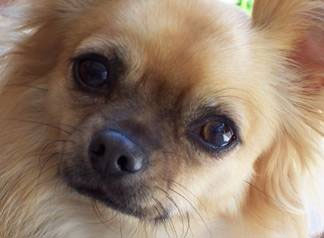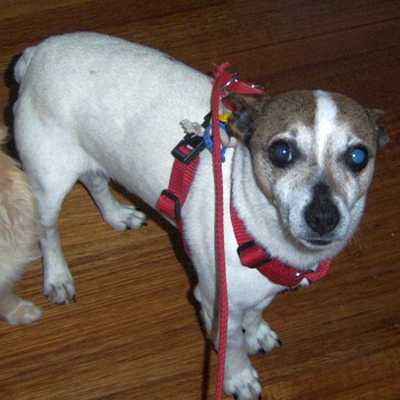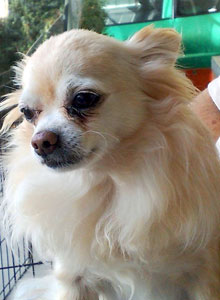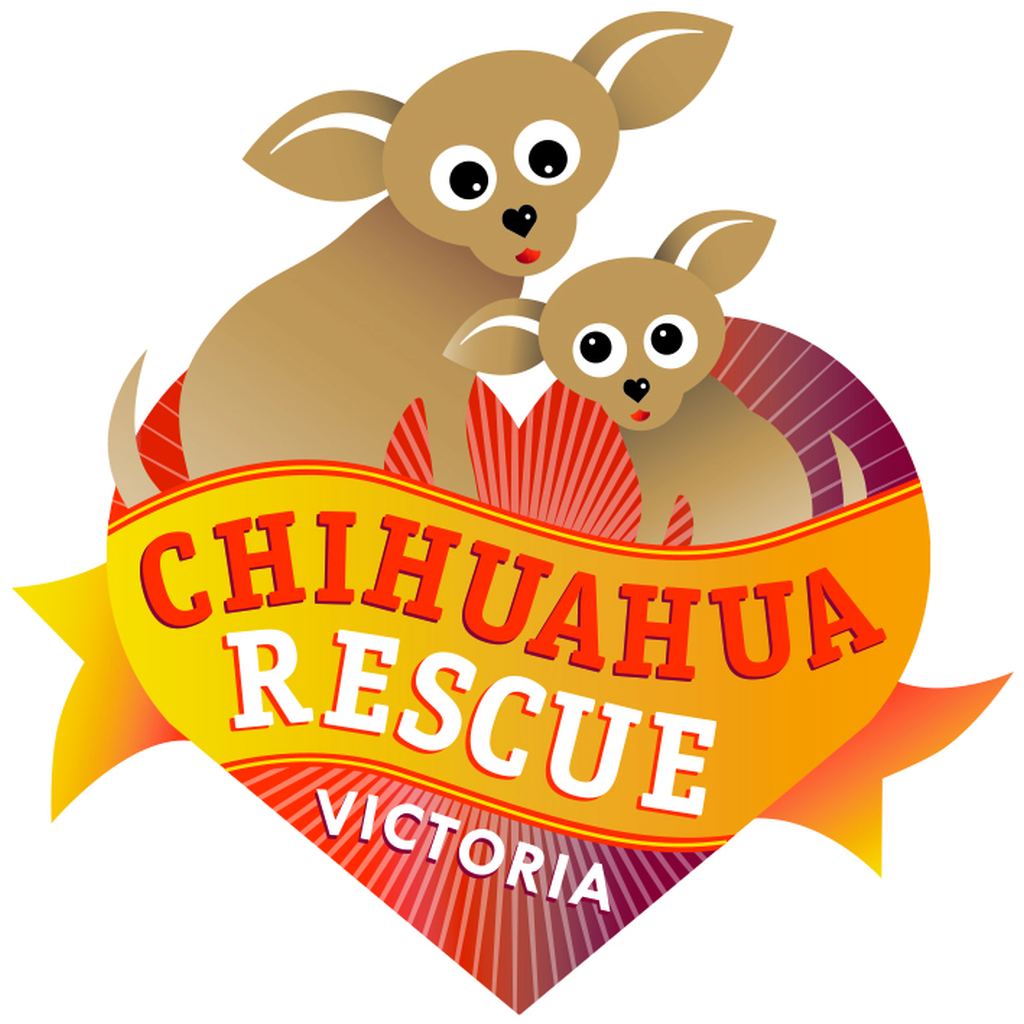Chihuahua Trivia
About the breed
The Chihuahua is a Purebred dog originating from Mexico.
Their appearance

As you can see, they are generally:
- alert;
- graceful;
- swift moving;
- fined boned but muscular;
- narrow of muzzle;
- ears generally large and erect but also acceptable in the smaller version;
- slightly arched neck;
- smooth or long hair;
- saucy expression;
- tail moderately long and carried upwards in a sickle shape or as a loop that touches the back.
Their age

Since we began doing Chihuahua Rescue, the most often asked question is "how old is he?" Most times we have no idea of the dog's previous history, experiences, or age. The whole exercise has to be guesswork, and observation. We see little Chihuahuas come in with bruising, swelling, no teeth, bitten ears or tails, flea ridden and starved, riddled with worms etc. The treatment is immediate when they come to us. Our Vet is on 24 hour standby for Chihuahua Rescue. The very first priority is to make sure the dog is not in pain and to immediately treat that - as pain will cause shock and sudden death. Providing the dog is otherwise fairly healthy he is given his "shots" and taken back to Rescue House and given a flea bath, gently towel dried, and treated with a permanent flea treatment; given a worm tablet, a nice warm feed and drink, then placed in isolation away from the other Chihuahuas. During his time in isolation we observe him for signs of illness, or mental problems etc. He is then introduced to the other dogs and becomes a member of our household (albeit on a temporary basis), and treated as a member of the family. He is taught to respect his human carers and fellow Chis.
He is neutered and once over the operation, is given follow up worm treatment to ensure that all worms are destroyed before he goes to a new home.
Age? We look at their teeth. A younger dog has short fangs, and they are usually a good white colour. As they age the fangs become longer and darken, and sometimes fall out. The Chihuahua has a very fragile jaw bone structure so there is not a great deal of bone to hold the teeth in place. The "daintier" the jaw bone the more likely the teeth will fall out at a much younger age.
Compared to human years a puppy of six to twelve months is just into his teenage years, that is twelve to fifteen human years. A dog from 18 months to 3.5 years is equal to 20 to 30 human years. Six doggy years is about 40 human years. By the time a dog is 8 to 9 years old he starts to slow down a bit; he is now around 50 to 60 human years.
We know that Chihuahuas are the longest living of any dog breed. The general "saying" is that the smaller the dog — the longer their life span. However, this is not entirely correct. Standard sized Chihuahuas have the longest life spans among the different Chihuahua dog breeds: the very small Chihuahuas generally have shorter life spans. This is because they are usually small due to genetic faults, being runt of the litter etc. They are NOT, and CANNOT be bred as "teacup" and "teapot" Chihuahuas. These two terms are myths. The longer living Chihuahuas (when not overfed and overweight) weigh between 1.5 kg to 2.5 kg or thereabouts. It is also known for some larger sized pure Chihuahuas to be 3 to 4 kg.
Attitude and temperament

Considering the size of the Chihuahua no other dog could be more intelligent and willing to learn. Most importantly the Chihuahua is actually a DOG despite its size, and as such should be treated like a dog — you protect them, train them, feed them, and by so doing your little Chihuahua will look up to you as the leader of the pack.
Are they a protective breed?

This little dog is a natural watchdog and will protect his home and owner till his dying breath. In the mind of the Chihuahua he thinks he is a Great Dane!
Average size when fully grown

The Chihuahua is the smallest dog in the world and when we look at "average" size we normally refer to the weight of the dog rather than height. The average body weight of a standard sized Chihuahua can (and does) vary from 1 kg to 3 kg. The males and females of the species are very similar in structure and size.
Average number of puppies per litter

2 to 3, most often 1, but known to have produced 6 to 7 (not necessarily all living).
Puppy Litters

Breeding Chihuahuas is not for the faint-hearted. Costs are very high, litters are small, and the survival rate is not as good as for larger breeds. It is imperative that you are with the bitch when she is due to whelp as they need assistance due to their very small size. Anyone planning to breed the Chihuahua should approach their respective Chihuahua Club and get as much information as possible before attempting this program.
Average life expectancy

The Chihuahua is the longest living of any other breed of dog. However, to qualify this statement, and to assist in ensuring that this is the case, the little Chihuahua must be fed as a dog, and not pampered and coddled to the extent of feeding human processed food, thus shortening the life of the Chihuahua. So to assist with the longevity of your Chihuahua a proper diet is required. You should feed them a good quality commercial dried dog food as these contain all the nutrients required and supplement that with some wet food such as a home made stew containing meat, rice, oils and vegetables. Read more about our suggested diet for Chihuahuas on the Caring for a Chihuahua page.
So, bred well and fed properly the AVERAGE life expectancy of a standard sized Chihuahua is 14 to 15 years, but not unusual for them to live 20 plus years. The very tiny Chihuahuas do not have the same average life expectancy due to the fact they are the runts of a litter which can be caused by some genetic fault, lack of nourishment in the womb etc., and as such these little ones have an average life expectancy of only 5 to 6 years.
Suitable living conditions indoors and outdoors

These little dogs are definitely indoor dogs, but love the outdoors as well. They love to wander in the grass (and chew on it sometimes); dig in the dirt; lie in the sun; and just explore the yard. When it gets cooler they are ready to come inside and curl up on your lap in front of the fire! Smooth coat or long coat these little dogs do feel the cold and appreciate a warm bed with a warm covering that they can snuggle into.
Grooming

Chihuahuas do not tend to have doggy odours like other breeds. They do like to be clean and this can be achieved with regular grooming. Most like to be bathed occasionally and get very excited after being towel rubbed and let down to shake and run wildly around in the sun after a bath, then come running up to you with such a gleeful attitude it is hard to know if they are saying "gee that feels good" or "well I got through that OK".
Bathing a Chihuahua too often tends to "dry out" its coat and skin which flakes like dandruff. Bathing the Chihuahua is not necessary on any sort of regular basis, just regular grooming and brushing. Both the smooth coat, and long coat, need brushing and combing to remove excess hair and to assist in keeping the coat glossy and healthy. Regular grooming can and does lessen the need for constant bathing.
Health problems

Most specific health problems are all part and parcel of the breed and you accept that as part of the pleasure of owning a Chihuahua. Some common health issues that affect Chihuahuas are:
- Molera is a soft spot on top of the head.
- Luxating patella is similar to a dislocating knee joint. If and when the condition becomes extreme the knee can be operated on to fix the problem.
- Sugar drop can and does cause death if not acted on quickly. It is more common in the very tiny dog and occurs when exercising, or if the dog has not eaten properly.
- Overweight. Due to those large begging eyes most humans cannot resist giving tidbits and too many treats! The dog becomes very overweight and suffers heart problems, as with humans.
Many of the health conditions you encounter with Chihuahuas are treatable or at least can be alleviated with proper care. Read more about health conditions that can affect your Chihuahua on our Caring for a Chihuahua page in the Health Issues section.
Do they get along with other animals?

These little dogs will certainly get along with other dogs, cats, birds etc. if trained that way. If you have two or more Chihuahuas they will be devoted friends and become quite lonely when one departs.
Where did they originate?

Originally it was thought that a tribe called the Toltec Tribe who lived near Mexico City had a breed of dog called the Techichi, and it is believed the Chihuahua (named after the largest state in Mexico) is descended from these dogs. The Aztecs conquered the Toltec Tribes and we believe they adopted the small and mute Techichi dog which became highly prized. When Cortez took Mexico in 1520 the breed almost died out. Thankfully it did not. That is one theory.
The origins of this small dog are really unknown, and to this day, this still puzzles historians.
Some excavations in Egypt during the last 20 years have unearthed the mummified remains of very small dogs dating back over 3000 years.
Another belief is that Chinese traders brought the breed to Mexico, and again, could date it back to the ancient Egyptians.
Tourists to Mexico brought the Chihuahua into America during the mid 1800's. The first Chihuahua registrations were during 1923 in USA.
History of Chihuahuas in Australia

Information from the Chihuahua Club of Victoria suggests that the first four Chihuahuas were introduced into Australia in December 1955 by Mrs E.M. MacMahon of Victoria. It was with these four original Chihuahuas that the famous "Chicdale" breeding line was established. Mrs MacMahon was the founder of the Victorian Chihuahua Club.
Information from the Chihuahua Club of South Australia, is that the first Chihuahua female owned in South Australia was by Mrs R Truscott in 1958 - Salford Chi Chi.
Mr Alan and Mrs Peggy Rochford came to Australia from England in 1960 bringing with them seven Chihuahuas into S.A.
Chihuahua Rescue Victoria is a non-profit organisation. The advertisement below supports us directly but was not created by us and is in no way endorsed by us. It is presented here by Google Ad Services.

